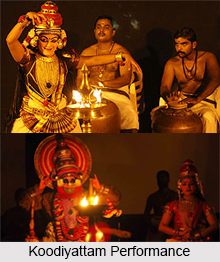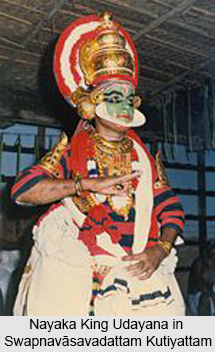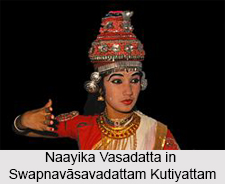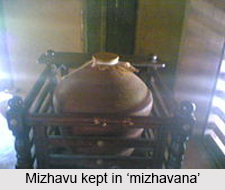 The performance of Koodiyattam, the oldest surviving Sanskrit theatre art form, comprises of a single act at a time, usually lasting several days with the enacting in the original form of a single act stretching up to 41 days. Koodiyattam blends ritual, sacred traditional precepts and rehearsed elements with creative improvisation. It will begin at 9 p.m. after the close of rituals in the sanctum sanctorum of the temple, and continue till midnight, sometimes till 3 a.m., before the commencement of the morning rituals.
The performance of Koodiyattam, the oldest surviving Sanskrit theatre art form, comprises of a single act at a time, usually lasting several days with the enacting in the original form of a single act stretching up to 41 days. Koodiyattam blends ritual, sacred traditional precepts and rehearsed elements with creative improvisation. It will begin at 9 p.m. after the close of rituals in the sanctum sanctorum of the temple, and continue till midnight, sometimes till 3 a.m., before the commencement of the morning rituals.
Enactment of Koodiyattam
The long and drawn out Koodiyattam performances are preceded by the initial invocatory rituals, which take place on the first day. These are followed by the Purappudu, or preliminaries, in which the actor performs certain abstract notes of movement behind a curtain. There is as such no acting in the performance of the first day that possibly ends with these movements. Thereafter is the phase of Nirvahana, a practice unique to Koodiyattam in which the character introduces himself by presenting his personal history that might also include his previous life. The actor can choose any legend which he wishes to emphasize, associated with his character. This allows him to explore the character to a degree unusual in Indian theatre. The first few days are entirely devoted to character introductions as well as incidents from their lives.
The entire play from beginning to end is performed on the last day. However, the entire written text is not enacted. Although the play`s text is considered as sacred, it serves only as a nucleus, with the actor augmenting the text by building upon its structure with improvised real and fantastic associations. A play becomes often motionless while the actor through his eyes, face and body explores a variety of emotions.
Each verse of the play is interpreted thrice. First, it is recited and expressed in Abhinaya, which is the dramatic form using stage conventions to render meaning. Thereafter it is slowly chanted with the meaning of each word explicated in greater depth. Following this is the longer and freer improvisation based on key words and ideas. This elucidation of verses gives immediate relevance to the audience, thus evoking introspection in addition to entertaining.
Role Playing in Koodiyattam
Koodiyattam is a dramatic presentation in Sanskrit, with the exception of the Vidushaka, who is the only character speaking in Malayalam. It is enacted inside the temple theatre known as Koothambalam, with two or more characters on stage at the same time. Role playing in Koodiyattam includes stylized form of vocal recitation coupled with a complete hand-gesture language and highly evocative facial expressions. The "vidushaka" or Jester plays the pivotal role. A figure parallel to the Fool in Shakespearean plays, Vidushaka serves as a bridge between the actors and the audience. He translates the Sanskrit version into colloquial Malayalam language, also giving a live image of the characters in the minds of spectators. The obscure passages are explained with the help of humorous commentary. He makes Koodiyattam relevant for audiences who do not understand Sanskrit and enacts his role with the liberty to criticize anyone without fear.
The performers of Koodiyattam must be skilled in the four main Abhinayas or arts of expressions, as described in the Natyashastra, namely "angika" (movement of the body), "vachika" (speech), "aharya" (external accessories such as costumes, props, ornaments and lighting) and "sattvika", which is an actor"s expression of real natural emotion, achieved by identifying and correlating with some personal experience. Koodiyattam uses a stylized, highly evolved mime language that emphasizes facial expressions and hand gestures. Such complicated gesture language, chanting and the amplified expressions of the face and eyes are complemented by elaborate headdresses and makeup.
Makeup and Costumes in Koodiyattam
The ritual application of Aharya Abhinaya (makeup) is used to create an outward expression of each character`s complex inner qualities. The symbolic use of colour is carefully calculated to make a statement. The makeup of most characters contains both black, representing "evil" and "paccha" (green) which roughly translates as "good", in different proportions. Heroic characters are distinguished by the green colour and the small curved paper frame on their face. The costumes have a blend of vibrant colours, predominantly red, black and white. The costume of the "vidushaka" (jester) sets him apart from the rest. He has specialised makeup, small headgears and costume that vividly display his clownish facets.
Musical Elements and Orchestration in Koodiyattam
The musical accompaniment chiefly encompasses the use of Mizhavu drums, which are large percussion instruments made of either clay or copper, with a narrow mouth covered by leather and played by both hands by the Nambiars, who sit at the rear of the stage. These huge drums have a great symbolic significance, setting the mood for the play and heightening its drama. The Nambiars also keep the "talam", which is the rhythmic pattern. They are accompanied by the Nangyaramma (women of the Nambiar caste) who play the Kuzhitalam, a type of cymbal, and sing the main verses of the drama in Sanskrit. Further accompaniments may be made by the Etakka, an hour-glass shaped drum that lends "bhava" and "laya" for a vivid portrayal of the soft sentiments of both male and female characters in Koodiyattam, the "kuzhal" which is an oboe-like wind instrument and the "shankha" (conch shell).
The staging of the entire act lasts three to five nights. The exposition of a single verse can take up to around two hours of acting while a whole play may require forty days for total presentation.
Related Articles:
Sanskrit Language
Forms of Indian Theatre
Kerala
Folk Theatre of Kerala
Sanskrit Theatre
Classical Indian Dance Drama
Koothu
Abhinaya, Indian Art Form
Vidushaka
Angika Abhinaya
Aharya Abhinaya




















